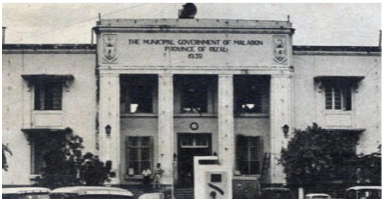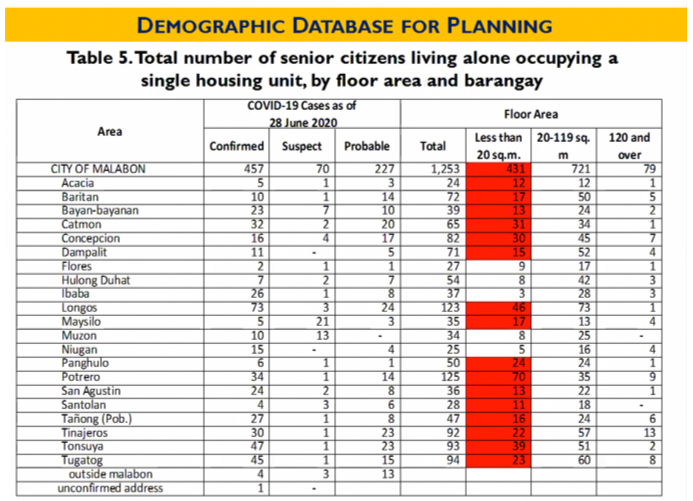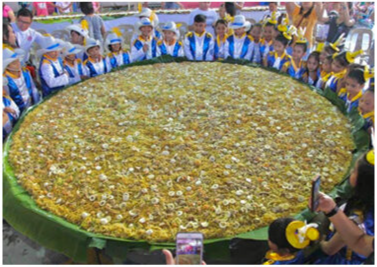
Malabon, officially the City of Malabon (Tagalog: Lungsod ng Malabon), is a 1st class highly urbanized city in Metropolitan Manila, Philippines. According to the 2015 census, it has a population of 365,525 people.
Located just north of Manila, it is primarily a residential and industrial town and is one of the most densely populated cities in the metropolis. It has a total land area of 15.96 square kilometers.
Malabon is part of the sub-region of Metro Manila informally called CAMANAVA, which consists of CAloocan, MAlabon, NAvotas, and VAlenzuela cities. Caloocan lies to the south and east, Navotas to the west, and Valenzuela to the north. Malabon also borders the town of Obando in the province of Bulacan to the northwest.


Legends considers the city’s name to be a contraction of Tagalog phrase marking laboring (plenty of bamboo shoots), as the place once abounded in this edible root. Originally called Tambobong (an early tagalog word for barn made of bamboo). Malayan was founded as a visita (hamlet) of tondo by the Augustinians on May 21, 1599. It remained under the administrative jurisdiction of the Provice of Tondo from 1627 to 1688.p
Malayan played an important economic role in the late 19th century with the founding of La Princesa Tabacalera tobacco company in 1851 and the Malabon Sugar Company in 1878. La Princesa was under the corporate umbrella of Compañia General de Tabacos de Filipinas (owned by the Spanish Crown), while the latter pioneeed the refined sugar industry in the Philippines.
The newspaper La Independence was first printed in Malabon’s Asilo de Huerfanos (Orphanage), where children orphaned by the Plague of 1882 were housed.
Malayan was officially made a municipality of the newly created Province of Rizal on June 11, 1901 by virtue of Philippine Commission Act No. 137. (8) When Act No. 942 was promulgated, Malabon was united with Navotas under a new government. On January 16, 1906, Act Bo. 1441 partitioned Malabon from Navotas into two separate municipalities of Rizal.
The first Mayor of Malabon was Don Don Agustin Salamanca, a Spanish mestizo originally from Cavite. The first Filipino Mayor of Malabon was Don Vicente P. Villongco. This was in 1899 at the onset of the American regime.
Malayan remained a municipality of Rizal until November 7, 1975, by virtue of Presidential Decree No. 824, when Malabon became a part of the National Capital Region or Metro Manila. (10) Malabon became a highly urbanized city on April 21, 2001, under Republic Act No. 9019, 407 years after its founding.
In 2020, the city and the entire Metropolitan Manila was placed under a community quarantine for one month starting March 15 due to the 2020 coronavirus pandemic.
Malabon is one of the most densely populated cities in the Philippines and its low-lying, flat terrain makes it prone to frequent flooding, especially during high tides, heavy rains and when the river and dams overflow. The four cities in CAMANAVA are commonly affected by interconnected rivers, one of which is the Tullahan River.
The river system used to be navigable and fishing was the major livelihood activity in the area. The River used to be wider and deeper with better quality water, and was a regular source of different species of fish, an important food source for local residents. Also, trees and crops like play (rice) and vegetables used to be grown along the riverbanks. However, these agricultural plots have been replace by industrial yards, which also became home to thousands of informal settlers who built makeshift dwellings without legal claim to the land.
Floods have worsened in recent years, occurring more frequently and reaching depths of several feet. Most affected are families in the communities that are along or near the riverbanks. The river has become narrower and shallower over the years, and its capacity to hold water has decreased. With more frequent intense rains, the riverbanks flood regularly and flooding reaches farther into low-lying and densely populated areas of the city.
Before the present-day Malabon, the town was originally composed of sitios (barangay) and others were further divided into two or more purok (zone).





Malayan belongs to the Roman Catholic Diocese of Kalookan under the episcopal seat of Bishop Pablo Virgilo David. Almost 80% of the people here adhere to this religion. Today there are eight Roman Catholic Parishes in Malabon.
Other religions in Malabon include Iglesia Filipina Independent ( belongs to the Diocese of Rizal and Pampanga, Parish of La Purisima Concepcion de Malabon), Baptists, Jesus the Living Stone International Assembly of God, Iglesia ni Cristo or Church of Christ, Members of the Church of God International, Jesus Is Lord Church, IEMELIF and Seventh-day Adventist.


Malabon industries include sugar refinery, patis (fish sauce) making, cigar-making, candle production, fishing and ilang-ilang flower-extract production (the distilled perfume is exported).
On April 21, 2008, Malabon City’s newly constructed 11-storey city hall building along F. Sevilla Blvd. in Barangay San Agustin, was inaugurated by Gloria Macapagal-Arroyo on Malabon’s 7th City Anniversary. It was dubbed as a “potential business center of the city,” a one-stop shop for government transactions, due to its state-of-the-art facilities such as 3 high-speed elevators and the new city hall building and its offices’ “digital system.”


Malabon is full of history and culture; thus, making it one of the cities in Metro Manila with truly rich emerging destinations.
The Malabon City Tourism Office launched the Malabon Tricycle Tours in December 2014. Malabon Tricycle tours aims to show the cultural wonders of Malabon City--using tricycles as a means of transportation. The tricycle tour offers three packages: the Heritage Tour, the Food Trip Special, and the Food & Heritage Tour, all boasting the rich culture and history of the city.
The tours take visitors to eight heritage sites including the newly renovated 400-year-old San Bartolome Church as well as to notable heritage houses like the Raymundo House and Ibaviosa House, and also offer visitors a unique gastronomic experience through visits to the city's home-based eateries.


The City of Malabon is a place famous for its Pancit Malabon and its predominantly Atlantic ambience. It is also famous for other variety of foods (kakanin), such as puto sulot, puto bumbong, sapin-sapin, broad, bibingka and camachile. The culinary delights are abundant in its specialty eateries.
Its most famous festival is the “Pagoda-Caracol”, a fluvial procession with street dancing to commemorate the Feast of the Immaculate Conception every December 8.


Malayan houses several old homes of historical value: the Dionisio family home, the Rivera house, the Villongco house, the Luna house, the Martinez house, the Chikiamco house, the Rojas-Borja house, the (Teodoro) Luna house, the Santos-Lapus house, the Pantaleon Bautista house, the Syjuco (formerly Gaza) house, and the Raymundo house, considered to be the oldest located along C. Arellano Street. Other old but well-preserved heritage houses in Malabon include the Asilo de Huerfanos, the Paez House, and the Nepomuceno House.